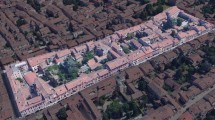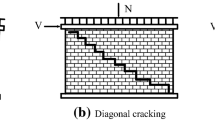Abstract
Damage to rural buildings in mountainous regions caused by flash floods accounts for a significant proportion of economic losses from disasters. The unreinforced masonry (URM) wall is the most vulnerable structural element of rural buildings exposed to flash floods. The failure of a URM wall indicates damage to rural buildings in flash floods. Based on the yield line theory of out-of-plane damage of URM walls and the virtual work method, brittle failure criteria for URM walls under the impact of flash floods were established. According to the field investigation data of the 26 June 2020 flash flood event in Damawu Gully and the corresponding simulation results of FLO-2D, the disaster-causing process was analysed, and the failure criteria were validated. Three building parameters were identified to influence the flood-resistance of URM walls, including the mortar grade, the span-to-height ratio of the wall, and the number of floors of the rural building. The results showed that the cause of the 26 June disaster was the diversion of a 50-year flash flood into the residential community on the alluvial fan. The affected buildings were constructed with hollow blocks and lacked flood-resistance reinforcement. The critical failure depth of a URM wall restrained at the top by ring beams (RBs) under hydrostatic load conditions is 1.17 to 1.20 times greater than that of a URM wall without RBs, and the difference is even more pronounced when lower-strength mortar is used. The flood-resistance of a URM wall constructed with Mb 7.5 mortar and restrained by RBs is almost as strong as that of a URM wall constructed with Mb 20 mortar and without RBs. The span-to-height ratio of a URM wall should not be greater than 1.875 in this case. However, the flood-resistance of a URM wall with RB restraint is almost independent of the span-to-height ratio. The brittle fracture energy of masonry mortar is more crucial to the flood-resistance of 4-edge restrained URM walls if L/Z > 1.875. The flood-resistance of the URM wall of the first storey increases linearly with the number of floors. Single-storey rural buildings should be given priority to the use of high-grade masonry mortar and high-density blocks to improve flood-resistance. The failure criteria and the influence laws of building parameters on the flood-resistance of URM walls can provide references for flash flood mitigation and flood-resistance reinforcement of rural buildings in mountainous regions of Southwest China.
Similar content being viewed by others
Abbreviations
- B :
-
room depth of the affected building
- E :
-
Young’s modulus of elasticity of masonry mortar after setting
- E Gf :
-
brittle fracture energy absorbed by the masonry mortar during the formation of wall cracks
- Fr :
-
Froude number
- f d, f s :
-
tensile and compressive strength of masonry mortars
- f n :
-
the number of floors above the ground floor of the building
- G f :
-
brittle fracture energy required to form a crack per unit area of wall surface
- g :
-
gravitational acceleration, equal to 9.8 m/s−2
- H :
-
height of affected buildings
- h, h max :
-
flow depths at affected buildings and maximum flow depth in each cell in the simulation of FLO-2D
- h 1, h 2 :
-
maximum depth and run-up height indicated by flood marks on the affected building
- h f :
-
critical depth of flash flooding in case of failure to URM walls
- h w :
-
flash flood depth for calculating wall stability
- h u :
-
height of hollow blocks
- i :
-
rainfall intensity in the calculated area during the FLO-2D simulation
- L :
-
length of affected URM wall
- L f :
-
total length of cracks in the wall panel
- l u :
-
length of hollow blocks
- N 1, N 2, N 3, N 4 :
-
force on top of each block in case of wall failure
- n :
-
Manning’s roughness coefficient for the FLO-2D simulation
- n o :
-
pressure on the top of URM walls
- P :
-
probabilities corresponding to different return periods
- p(z):
-
flash flood pressure on the wall at a height of z from the ground
- Q m :
-
maximum peak discharges for flood processes with different return periods
- S fx, S bx, S fy, S by :
-
friction and channel bed slope in the x and y directions in the FLO-2D simulations
- Ŝ :
-
ratio of the actual flood impact pressure on the URM wall to the hydrostatic pressure
- t :
-
moment since the start of runoff production at the tributary confluence or thickness of the URM wall
- t m :
-
moment when the maximum peak discharge occurs for different return periods
- t j :
-
thickness of mortar joints
- u, v :
-
the average velocity along the depth in the x and y direction, respectively
- v max :
-
maximum velocities of flash floods at damaged buildings
- W 1, W 2, W 3, W 4 :
-
weight of each block after wall failure
- W f, W s :
-
failure work done to URM walls by flash flood impact loads, stabilising work of the URM wall
- Z :
-
height of the URM wall
- α :
-
angle between the diagonal crack in the wall and the vertical direction
- α c :
-
contribution ratio of brittle fracture energy to the wall stability work
- γ w, γ o :
-
weights of the URM wall and flash flood, respectively
- δ 1, δ 2, δ 3, δ 4 :
-
horizontal displacement of each block at the time of failure to the URM wall
- ε dmax :
-
ultimate tensile strain in masonry mortar for URM wall failure
- ε H,ε v :
-
maximum tensile strain in the horizontal and vertical directions for URM walls, respectively
- θ 1 :
-
rotation angle corresponding to blocks 1, 4 under flash flood action
- θ 3 :
-
rotation angle corresponding to blocks 2, 3 under flash flood action
- ξ 1, ξ 2, ξ 3, ξ 4 :
-
vertical displacement of each block at the time of failure to the URM wall
- ξ N1, ξ N2, ξ N3 :
-
vertical displacement of the top of each block at the time of failure to the URM wall.
References
Adhikari RK, D’Ayala D (2020) 2015 Nepal earthquake: seismic performance and post-earthquake reconstruction of stone in mud mortar masonry buildings. Bull Earthq Eng 18(8): 3863–3896. https://doi.org/10.1007/s10518-020-00834-y
Angiolilli M, Lagomarsino S, Cattari S, et al. (2021) Seismic fragility assessment of existing masonry buildings in aggregate. Eng Struct 247. https://doi.org/10.1016/j.engstruct.2021.113218
Armanini A, Larcher M, Odorizzi M (2011) Dynamic impact of a debris flow front against avertical wall. International Conference on Debris-Flow Hazards Mitigation: Mechanics, Prediction, and Assessment, Proceedings: 1041–1049. https://doi.org/10.4408/IJEGE.2011-03.B-113
Armanini A, Rossi G, Larcher M (2020) Dynamic impact of a water and sediments surge against a rigid wall. J Hydraul Res 58(2): 314–325. https://doi.org/10.1080/00221686.2019.1579113
Baker C, Chen B, Drysdale R (2005) Failure line Method Applied to Walls with Openings. In: 10th Canadian Masonry Symposium, Banff, Canada.
Bi YZ, Du YJ, He SM, et al. (2018) Numerical analysis of effect of baffle configuration on impact force exerted from rock avalanches. Landslides 15(5): 1029–1043. https://doi.org/10.1007/s10346-018-0979-z
Chang LZ, Messali F, Esposito R (2020) Capacity of unreinforced masonry walls in out-of-plane two-way bending: A review of analytical formulations. Structures 28: 2431–2447. https://doi.org/10.1016/j.istruc.2020.10.060
Chang LZ, Rots JG, Esposito R (2021) Influence of aspect ratio and pre-compression on force capacity of unreinforced masonry walls in out-of-plane two-way bending. Eng Struct 249. https://doi.org/10.1016/j.engstruct.2021.113350
Chen M, Tang C, Zhang XZ, et al. (2021) Quantitative assessment of physical fragility of buildings to the debris flow on 20 August 2019 in the Cutou gully, Wenchuan, southwestern China. Eng Geol 293:106319. https://doi.org/10.1016/j.enggeo.2021.106319
Derakhshan H, Lucas W, Visintin P, et al. (2018) Out-of-plane Strength of Existing Two-way Spanning Solid and Cavity Unreinforced Masonry Walls. Eng Struct 13: 88–101. https://doi.org/10.1016/j.istruc.2017.11.002
Du J, He XY, Wang ZY, et al. (2015) Experimental study of the interaction between building clusters and flash floods. J Mt Sci 12(5): 1334–1344. https://doi.org/10.1007/s11629-014-3170-6
GB 50011-2010. Code for seismic design of buildings. China Architecture & Building Press. pp 5–96. (In Chinese)
GB 50003-2011. Code for design masonry structures. China Architecture & Building Press. pp 50–51. (In Chinese)
GB/T 8239-2014. Normal concrete small block. China Quality and Standards Publishing & Media Co.,Ltd. pp 1–5. (In Chinese)
GB/T 5101-2017. Fired common bricks. China Quality and Standards Publishing & Media Co.,Ltd. pp 1–4. (In Chinese)
Griffith MC, Vaculik J (2007) Out-of-plane flexural strength of unreinforced clay brick masonry walls. TMS Journal 25: 53–68.
Guo L, He BS, Ma MH, et al. (2018) A comprehensive flash flood defense system in China: overview, achievements, and outlook. Nat Hazards 92(2): 727–740. https://doi.org/10.1007/s11069-018-3221-3
He CR, Zhang R, Chen Q, et al. (2011) Earthquake characteristics and building damage in high-intensity areas of Wenchuan earthquake I: Yingxiu town. Nat Hazards 57(2): 435–451. https://doi.org/10.1007/s11069-010-9624-4
Heffler LM, Stewart MG, Masia MJ, et al. (2008) Statistical analysis and spatial correlation of flexural bond strength for masonry walls. Mason Int 2008;21(2):59–70.
Hendry AW, et al. (1997) Design of Masonry Structures. Boca Raton, US, CRC Press. pp 153–175.
Hu KH, Cui P, Zhang JQ (2012) Characteristics of damage to buildings by debris flows on 7 August 2010 in Zhouqu, Western China. Nat Hazard Earth Sys Sci 12(7): 2209–2217. https://doi.org/10.5194/nhess-12-2209-2012
JGJ/T 14-2011. Technical specification for concrete small-sized hollow block masonry buildings. China Architecture & Building Press. pp 85–86. (In Chinese)
Kelman I and Spence R (2004) An overview of flood actions on buildings. Eng Geol 73: 297–309. https://doi.org/10.1016/j.enggeo.2004.01.010
Li J, Stewart MG, Masia MJ, et al. (2016) Spatial Correlation of Material Properties and Structural Strength of Masonry in Horizontal Bending. J Struct Eng-ASCE 142(11). https://doi.org/10.1061/(ASCE)ST.1943-541X.0001488
Li SQ, Chen YS (2020) Analysis of the probability matrix model for the seismic damage vulnerability of empirical structures. Nat Hazards 104(1): 705–730. https://doi.org/10.1007/s11069-020-04187-2
Li, YM, Su LJ, Zou Q, et al. (2021) Risk assessment of glacial debris flow on alpine highway under climate change: A case study of Aierkuran Gully along Karakoram Highway. J Mt Sci 18(6):1458–1475. https://doi.org/10.1007/s11629-021-6689-3
Li Y, Liu XN, Gan BR, et al. (2021) Formation-Evolutionary Mechanism Analysis and Impacts of Human Activities on the 20 August 2019 Clustered Debris Flows Event in Wenchuan County, Southwestern China. Front Earth Sci 9:433. https://doi.org/10.3389/feart.2021.616113
Liberatore L, AlShawa O (2021) On the application of the yield-line method to masonry infills subjected to combined in-plane and out-of-plane loads. Structures 32: 1287–1301. https://doi.org/10.1016/j.istruc.2021.03.044
Lourenço PB, Avila L, Vasconcelos G, et al. (2013) Experimental investigation on the seismic performance of masonry buildings using shaking table testing. Bull Earthq Eng 11(4): 1157–1190. https://doi.org/10.1007/s10518-012-9410-7
Milanesi L, Pilotti M, Belleri A, et al. (2018) Vulnerability to Flash Floods: A Simplified Structural Model for Masonry Buildings. Water Resour Res 54: 7177–7197. https://doi.org/10.1029/2018WR022577
Muhit IB, Stewart MG, Masia MJ (2022) Monte-Carlo laboratory testing of unreinforced masonry veneer wall system under out-of-plane loading. Constr Build Mater 321. https://doi.org/10.1016/j.conbuildmat.2022.126334
O’Brien JS, Fullerton WT (1999) Simulation of Rio Grande floodplain inundation using FLO-2D. In: Rio Grande ecosystems: linking land, water, and people: towards a sustainable future for the Middle Rio Grande Basin. 1998 June 2–5. U.S. Department of Agriculture, Forest Service, Rocky Mountain Research Station, Albuquerque, NM. Proc. RMRS-P-7. Ogden, UT. pp 52–60.
Pilotti M, Milanesi L, Ranzi R (2016) People and buildings vulnerability to floods in mountain areas. In: Koboltschnig G (ed.), Living with Natural Risks. 13th Congress INTERPRAEVENT 2016. Lucerne, Switzerland. pp 791–798.
Van der Pluijm R (1999) Out-of-plane bending of masonry: behaviour and strength. (PhD thesis). Eindhoven, Dutch, Technische Universiteit Eindhoven. p 25. https://doi.org/10.6100/IR528212
Si GW, Chen JG, Chen XQ, et al. (2021) Review of the types of rural building damage caused by the flash flood and the flood-resistant strengthening techniques. Science Technology and Engineering 21(23): 9671–9681 (in Chinese) https://doi.org/10.3969/j.issn.1671-1815.2021.23.003
Sorrentino L, D’Ayala D, Felice GD, et al. (2017) Review of Out-of-Plane Seismic Assessment Techniques Applied To Existing Masonry Buildings. Int J Archit Herit 11(1): 2–21. https://doi.org/10.1080/15583058.2016.1237586
Sun DY, Zhang DW, Cheng X (2012) Framework of National Non-Structural Measures for Flash Flood Disaster Prevention in China. Water 4(1): 272–282. https://doi.org/10.3390/w4010272
Tang Y, Wang LJ, Ma S, et al. (2021) A Study of the Post-Disaster Emergency Relief of Mudslide and Weir: Taking the “8·17” Mudslide Disaster in Wen County as an Example. Journal of Catastrophology 36(2): 124–129 (in Chinese) https://doi.org/10.3969/j.issn.1000-811X.2021.02.021
Vaculik J, Griffith MC, Magnes G (2014) Dry stone masonry walls in bending-part II: analysis. Int J Archit Herit 8(1): 29–48. https://doi.org/10.1080/15583058.2012.663060
Wang YY (2008) Lessons learned from the “5·12” Wenchuan Earthquake: evaluation of earthquake performance objectives and the importance of seismic conceptual design principles. Earthq Eng Eng Vib 7(3): 255–262. https://doi.org/10.1007/s11803-008-0886-8
Willis CR, Griffith MC, Lawrence SJ (2006) Moment Capacities of Unreinforced Masonry Sections in Bending. Aust J Struct Eng 6: 133–146. https://doi.org/10.1080/13287982.2006.11464950
Xiao C, Wu PL, Zhang LX, et al. (2018) Increasing Flash Floods in a Drying Climate over Southwest China. Adv Atmos Sci 35(8): 1094–1099. https://doi.org/10.1007/s00376-018-7275-7
Xiong J, Tang C, Chen M, et al. (2021) Activity characteristics and enlightenment of the debris flow triggered by the rainstorm on 20 August 2019 in Wenchuan County, China. Bull Eng Geol Environ 80(2): 873–888. https://doi.org/10.1007/s10064-020-01981-x
Yin YP, Wang FW, Sun P (2009) Landslide hazards triggered by the 2008 Wenchuan earthquake, Sichuan, China. Landslides 6(2): 139–152. https://doi.org/10.1007/s10346-009-0148-5
Zeng ZY, Tang GQ, Long D, et al. (2016) A cascading flash flood guidance system: development and application in Yunnan Province, China. Nat Hazards 84(3): 2071–2093. https://doi.org/10.1007/s11069-016-2535-2
Zhai CH, Wang XM, Li S, et al. (2011) An Improved Three-Strut Model for Masonry Infills in RC Frame Structures. Adv Mat Res 163–167(2011): 4129–4132. https://doi.org/10.4028/www.scientific.net/AMR.163-167.4129
Zhu L, He SM, Qin HK, et al. (2021) Analyzing the multi-hazard chain induced by a debris flow in Xiaojinchuan River, Sichuan, China. Eng Geol 293: 106280.
Acknowledgements
This work was funded by the National Key R&D Program of China (Grant No. 2018YFD1100401), the National Natural Science Foundation of China (Grant No. 41925030), the Sichuan Science and Technology Program (Grant No. 2019YJ0009), the National Natural Science Foundation of China (Grant No. 42007270), the Youth Innovation Promotion Association CAS (2022379), and the Chinese Academy of Sciences (CAS) Light of West China Program.
Author information
Authors and Affiliations
Corresponding author
Rights and permissions
About this article
Cite this article
Si, Gw., Chen, Xq., Chen, Jg. et al. Failure criteria of unreinforced masonry walls of rural buildings under the impact of flash floods in mountainous regions. J. Mt. Sci. 19, 3388–3406 (2022). https://doi.org/10.1007/s11629-022-7491-6
Received:
Revised:
Accepted:
Published:
Issue Date:
DOI: https://doi.org/10.1007/s11629-022-7491-6




